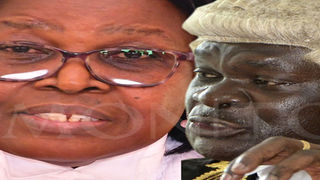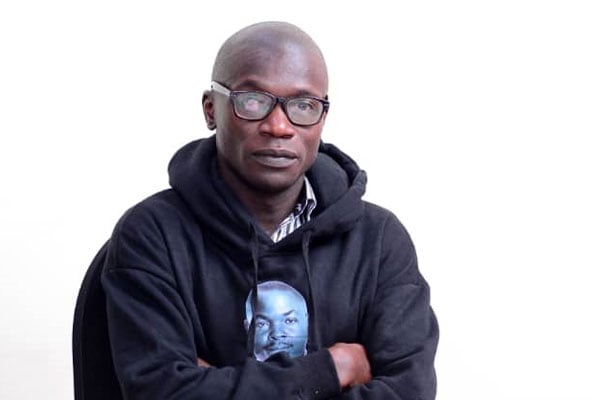
This photo combo created on October 16, 2022 shows Supreme Court Justice Esther Kisaakye and Chief Justice Alfonse Owiny-Dollo. PHOTO/FILE/ABUBAKER LUBOWA
|People & Power
Prime
Inside justices Kisaakye, Owiny-Dollo fallout
What you need to know:
- Showdown. It is not unprecedented that a judge goes to court seeking remedies, but it’s unprecedented for a judge to drag the entire Judiciary to court like Supreme Court Justice Esther Kisaakye has done.
- Yet having disagreed with fellow judges for years, it’s not surprising that Justice Kisaakye has finally taken the establishment to court.
When Justice Mike Chibita arrived at the Supreme Court in early 2020, there was conjecture that he could be the direct replacement of Chief Justice Bart Katureebe – who was clearing his desk as retirement beckoned.
Such noise was too much that Katureebe, according to sources, decided to handover the office of the most senior Justice at the Supreme Court to Chibita.
Only that it didn’t go down well with those who thought it was supposed to be Justice Esther Kisaakye to occupy this office.
The thinking was that since she arrived at the Supreme Court in 2009 – having been tapped by President Museveni from Makerere University – Justice Kisaakye was the most senior judge of the Supreme Court once Justice Katureebe, who arrived at the court in the fall 2005, hanged up his wig.
Justice Katureebe’s decision to give the office to Justice Chibita didn’t go unopposed: Justice Kisaakye, according to sources familiar with the Supreme Court, ordered Justice Chibita out of the office on grounds that he was too junior.
Chibita, who wasn’t interested in the fight, vacated the office and Kisaakye duly occupied it. The jostling over the office came at the time when Justice Kisaakye was eyeing the position of Chief Justice in which she was facing competition from former Director of Public Prosecutions (DPP) Richard Buteera, by then a Supreme Court judge, and then Deputy Chief Justice Alfonse Owiny-Dollo.
One of the grounds Justice Kisaakye used to pitch for this coveted job also hinged on seniority and precedent. When Justice Katureebe succeeded Chief Justice Benjamin Odoki in 2013, he was the most senior judge and so Kisaakye was under the impression that the same practice would apply to her.
However, in August 2020, unpalatable news, at least for Justice Kisaakye, emanated from State House that President Museveni had appointed Justice Owiny-Dollo, the most junior of three competitors, as Chief Justice.
President Museveni had consoled Justice Buteera with the position of Deputy Chief Justice, meaning he was to exchange positions with Justice Owiny-Dollo since the former prosecutor was now heading to the Court of Appeal, which doubles as the Constitutional Court.
Before President Museveni would appoint the Chief Justice, Justice Owiny-Dollo had told this writer that appointing Justice Buteera as Chief Justice wouldn’t have been a bad choice.
“I think I have what it takes to be Chief Justice, but from my competitors I think it’s Justice Buteera who would make a good Chief Justice. I would be happy if he was picked, instead of me,” Justice Owiny-Dollo said.
When Justice Owiny-Dollo arrived at the Supreme Court in the fall of 2020, he quickly asserted himself by ordering Justice Kisaakye out of the office she had occupied months earlier having kicked out Justice Chibita and this augmented the smouldering tensions further.
“Justice Kisaakye would challenge any directive made by the Chief Justice,” a source familiar with the standoff says. “She stopped attending Tuesday meetings which all Supreme Court justices are supposed to attend as they plan for the court and also agree how to manage case files.”
The acrimonious relationship between Justice Kisaakye and other Supreme Court justices first played out in the full glare of cameras at the conclusion of the withdrawn presidential petition filed by National Unity Platform (NUP) former presidential candidate Robert Kyagulanyi, popularly known as Bobi Wine, who was challenging President Museveni’s victory.
The eight justices – Chibita, Percy Tuhaise, Owiny-Dollo, Stella Arach-Amoko, Faith Mwondha, Rubby Aweri-Opio and Ezekiel Muhanguzi – gave one ruling explaining the reasons why they had rejected two of Kyagulanyi’s applications, in which he sought to amend his petition, and also one in which he wanted his more than 200 additional affidavits allowed out of time.
When the eight were done reading their combined ruling, it was Justice Kisaakye’s turn to read her “dissenting ruling”, but Justice Owiny-Dollo first asked for a short break which turned into a long break.
Once they went back to their chambers, the justices told the Chief Justice that without Justice Kisaakye disclosing her ruling, they weren’t returning to the tent where the case was being heard.
The culture at the Supreme Court and the Court of Appeal is that since they work in coram, judges share their rulings or judgements before the day of reading them for everyone to know how the other had decided, but judges at the Supreme Court accused Justice Kisaakye of keeping them in the dark about her decisions and reasoning.

The seven-member panel of Supreme Court justices that heard the age limit petition in 2019. PHOTO/FILE
They said she preferred to surprise them in court as she reads her rulings. Justice Kisaakye’s response to that accusation has been unequivocal.
“While it is good practice for members of the court to circulate their draft ruling to colleagues, there is no law in Uganda that I’m aware of that requires me to do so,” she said last year.
Stage set
The stage is set for Justice Kisaakye to take on the entire Judiciary having filed a constitutional petition against Justice Owiny-Dollo, Judiciary permanent secretary Pius Bigirimana, Chief Registrar Sarah Langa Siu, Judiciary’s commissioner for human resources Apophia Tumwine, the Judicial Service Commission (JSC) and the Attorney General, resurrecting last year’s standoff.
In her petition, she still defends her move not to disclose her rulings in accordance with the Chief Justice’s directive.
“Your petitioner informed the 1st respondent (Chief Justice) and other justices of the court that there was no constitutional or legal requirement imposed on her to share her reasons before delivery since court had already made all its decisions and issued the respective summary ruling in all the applications under reference,” she says in her affidavit in support of the petition.
“During the adjournment, the 1st respondent [Justice Owiny-Dollo] then directed your petitioner [Justice Kisaakye] not to deliver her ruling on grounds that your petitioner had not shared with the 1st respondent and other justices of the Supreme Court her detailed reasons for the respective rulings, which had been earlier reserved by the court,” she adds.
Following last year’s standoff, Justice Kisaakye claims in her petition, Justice Owiny-Dollo responded by summarily dropping her as the administrator of the court and replaced her with a junior judge, she doesn’t name – but this writer understands it’s Justice Arach-Amoko – something she claims is unconstitutional.
“Constitutionally, the position of the administrator of the Supreme Court is a preserve of the most senior member of the Supreme Court after the Chief Justice,” she says.
She also says her research assistant, a Grade One Magistrate, has since been withdrawn from her and transferred to Jinja and yet the research assistants for her fellow justices have never been transferred.
“That in contrast, the research assistants of all other justices of the Supreme Court who had also been appointed as Magistrates Grade l, were retained by the respective justices of the Supreme Court where they had been serving prior to the appointment,” she says.
“That on July 25, 2022, your petitioner copied to the 1st respondent [Justice Owiny–Dollo] her internal memo to the 4th respondent [Langa- Sui] where she pointed out this anomaly and its likely effect on the performance of her judicial duties, but both the first and 3rd respondents [Tumwine] did not take any action.”
Justice Kisaakye says she has not been allocated any work by the Chief Justice ever since she returned in June this year and the last judgement she gave was in November last year.
It was the Constitutional Court appeal by businessman Hassan Basajjabalaba and his brother Muzamiru Basajjabalaba who were challenging orders of the Constitutional Court to have them tried for fraud in which Uganda lost Shs20b.
Justices Ezekiel Muhanguzi, Faith Mwondha, Arach-Amoko, Chibita, Prof Lillian Ekirikubinza Tibatemwa and Tuhaise agreed to dismiss the petition and ordered the two brothers to be tried at the Anti-Corruption Court after they dismissed the duo’s contention that the Constitutional Court judgement couldn’t stand because Justice Steven Kavuma, who was part of the five-man panel, had retired without writing his own judgment or putting it in writing that he had agreed with the majority.
In dismissing Basajjabalaba’s appeal, the Supreme Court insisted that Justice Kavuma’s non-performance of his duties wouldn’t render the judgment by his colleagues a nullity.
“I am also alive to the provisions of Article 126(2) of the Constitution which provides that substantive justice shall be administered without undue regard to technicalities,” Justice Mwondha ruled. “I hasten to add that this is a matter of substantive justice which should be handled carefully and correctly.”
Justice Kisaakye, who led the panel, didn’t agree. “The Deputy Chief Justice, who was part of the coram, was expected to follow the practice that the head of the coram writes the orders of the court after all the members of the coram have rendered their individual decisions. However, by the time he ceased to be a member of the Constitutional Court, he had neither signed the majority judgement nor written his separate concluding or dissenting judgement or orders of the court which embodies the decision of the court.”
It’s not clear when Justice Kisaakye’s petition will be heard as the respondents are still filling their defences, but what’s clear is that all parties have dug in and this was exhibited in the defence filed by the Attorney General who has accused the judge of filling a petition in an efforts to duck disciplinary proceedings at the Judicial Service Commission.





